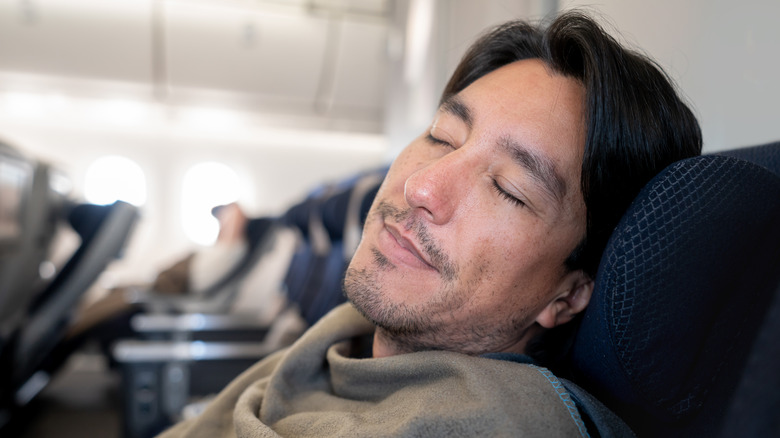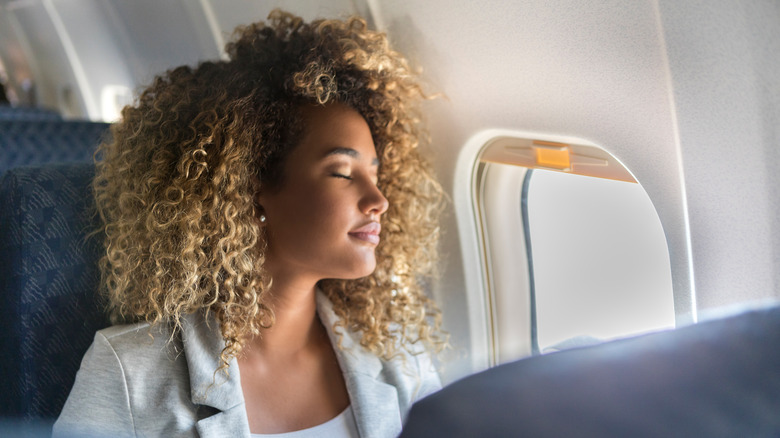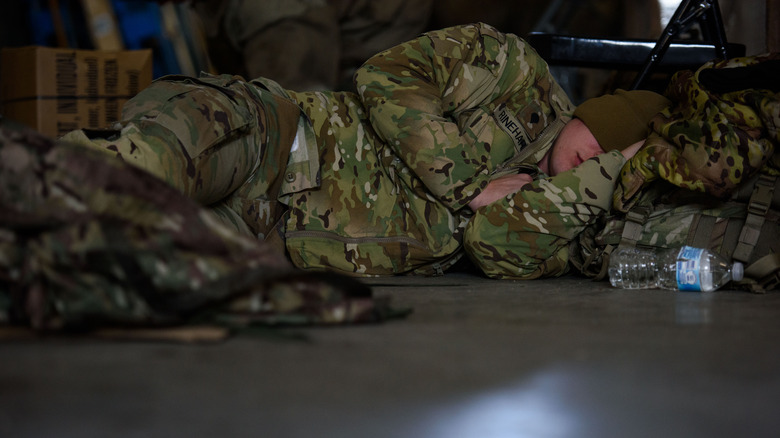Getting Quality Rest On Long Flights Has Never Been Easier With This Military Sleep Hack
Sleeping on a plane is notoriously difficult for many, and to make matters worse, beating jet lag often depends on it. If you're on a flight and struggling to get any shuteye, one military-approved sleep hack might just do the trick.
The military sleep method was first publicized in the 1981 book "Relax and Win: Championship Performance" by Lloyd Bud Winter, a Navy trainer turned track and field coach. More recently, the hack started making the rounds online, including in a viral Medium article and on TikTok. Proponents claim that the strategy can help anyone fall asleep in just two minutes, including military pilots and soldiers caught on the battlefield and in dire need of rest. In theory, if it works for them, it could work for you on a crowded, noisy flight.
Best of all, the military sleep hack doesn't require any special gadgets, travel pillows, or other devices. All that's required is your body (yep, even squished in the most uncomfortable plane seat) and a little bit of focus.
How to do the military sleep technique
The military sleep hack is simple, though it can take a little practice to get the hang of. The first step is to get as comfortable as you can in your plane seat and close your eyes. Then, relax your body from head to toe, starting with the muscles in your forehead. Work your way to your eyes, cheeks, and jaw, imagining each muscle becoming loose and heavy. As you relax each body part, try to slow your breath with deep and calming inhalations.
Then, use the same strategy with your neck, shoulders, arms, and hands, focusing on one body part at a time. Notice any tension and mentally release the tightness stored in each muscle. Picture yourself sinking into your seat. Continue this method in your chest, stomach, thighs, feet, and toes.
After relaxing your entire body, turn your attention to your thoughts. Commit to clearing your mind of any stressful or distracting ideas. Alternatively, TikToker Justin Agustin suggests visualizing yourself either lying in a canoe on a serene lake or in a hammock in a black room. If your mind still wanders, reel it in by mentally repeating "Don't think." In no time, you should find yourself drifting off to dreamland.
Does the military sleep hack really work?
Lloyd Bud Winter's famous military sleep technique is said to have helped a whopping 96% of the military men who tried it within six weeks. It's unclear how accurate those stats are — or how well the method will work for the occasional red-eye flight. However, there are a few reasons why the hack makes sense for sleepy flyers.
First, the viral hack employs a technique similar to progressive muscle relaxation to help you fall asleep fast. While researchers haven't studied its impact on flight passengers, progressive muscle relaxation was found to significantly improve sleep in COVID-19 patients in a 2020 study published in the journal Medicine. The military method also uses visualization to soothe stress-inducing thoughts. According to a 2017 study published in Critical Care Nurse, guided imagery — such as imagining yourself peacefully floating in a canoe — may reduce anxiety and insomnia symptoms, making it easier to doze off even in undesirable conditions.
Still, the military hack can take some time to get used to and might not work for everyone. If you struggle to fall asleep, try the next best thing: unwinding and relaxing until your flight lands. Close your eyes, even if you remain awake, or meditate quietly to soothe any travel nerves. When you arrive at your destination, try to carry on with a normal sleep routine to get back on track.


